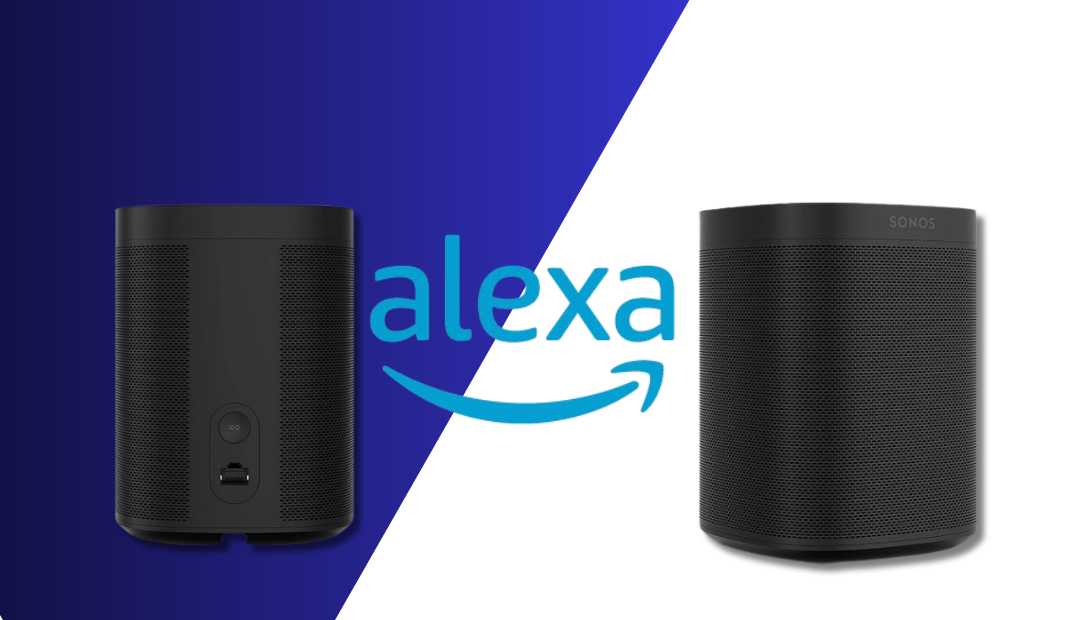Upgrading a home audio system is not a decision most people make lightly. For me, switching from the Sonos One SL to the Sonos One Gen 2 was more than just about upgrading to the latest and greatest—it was about addressing specific needs and elevating my listening experience.

If you’re trying to decide between these two excellent speakers, in this Sonos One SL vs Gen 2 comparison, we’ll dive into the differences and benefits of the two smart speakers and help you make an informed choice.
What Sets the Sonos One SL and Gen 2 Apart?
At first glance, both the Sonos One SL and the Gen 2 look similar. They share a sleek, compact design that seamlessly integrates into any home decor. However, their differences lie under the hood, and these distinctions make the Gen 2 a clear winner for me.
Key Features of the Sonos One SL
- Microphone-Free Design: The SL stands for “Speechless,” which means the Sonos One SL does not come with built-in voice control.
- High-Quality Audio: Offers the same crystal-clear, room-filling sound as the original Sonos One.
- Trueplay Tuning: Customizes the sound to the acoustics of your room.
- Seamless Integration: Works effortlessly with the Sonos ecosystem and supports Apple AirPlay 2.
Key Features of the Sonos One Gen 2
- Voice Control Built-In: Equipped with microphones and supports both Amazon Alexa and Google Assistant.
- Improved Internals: Features a faster processor and increased memory for smoother performance and better future-proofing.
- Same Audio Excellence: Delivers the same high-quality sound signature as the SL.
- Future-Ready Connectivity: Enhanced hardware allows for more updates and compatibility with future Sonos features.
Why I Chose to Upgrade
While the Sonos One SL served me well, there were a few limitations that made me consider upgrading to the Sonos One Gen 2. Here’s what convinced me:
1. Voice Control Integration
The Sonos One SL’s lack of microphones was initially appealing as I didn’t think I needed voice assistants. However, as my smart home ecosystem grew, I realized how much I relied on voice commands for convenience. The Sonos One Gen 2’s built-in Alexa and Google Assistant support made controlling my music, setting timers, and managing my connected devices a breeze.
2. Future-proofing with Enhanced Hardware
The Gen 2’s faster processor and increased memory might not seem like a big deal at first, but they make a noticeable difference in performance. The speaker responds more quickly to commands and handles software updates effortlessly. Knowing that the Gen 2 is better equipped for future updates gave me peace of mind.
3. Seamless Multi-Room Audio
Both speakers excel in multi-room audio capabilities, but the Gen 2’s enhanced internals make syncing across rooms faster and more reliable. Whether I’m throwing a party or simply enjoying music throughout my home, the Gen 2 handles it without a hitch.
4. Smart Home Compatibility
As my smart home setup expanded, I wanted a speaker that could act as a hub for my devices. The Gen 2 integrates beautifully with Alexa and Google Assistant, letting me control lights, thermostats, and other devices without needing additional hubs.
Breaking Down the Audio Experience
One area where both the Sonos One SL and Gen 2 truly shine is sound quality. Both speakers deliver a balanced, rich audio profile that adapts to any genre of music.
- Bass and Midrange: The bass is punchy without being overpowering, and the midrange is clear, making vocals and instruments stand out.
- Highs: Crisp and detailed, providing excellent clarity without harshness.
- Room Customization: Thanks to Trueplay tuning, both models adapt their sound to the acoustics of the room, ensuring optimal performance.
While the sound quality is nearly identical, the Gen 2’s updated internals mean it’s better equipped to handle complex audio setups in the future.
Practical Differences in Everyday Use
Ease of Use
- Sonos One SL: Simpler to set up and use, especially for those who prefer not to deal with voice assistants.
- Sonos One Gen 2: More versatile due to its voice control features and improved performance.
Connectivity
- Both models support Apple AirPlay 2 and integrate seamlessly with the Sonos app. However, the Gen 2’s enhanced hardware makes connecting and managing multiple devices quicker.
Privacy Concerns
- If you’re concerned about privacy, the SL is a microphone-free option, whereas the Gen 2 includes a physical button to disable the microphones when not in use.
Price Consideration
The Sonos One SL is slightly more affordable than the Sonos One Gen 2, making it a great option for budget-conscious buyers who don’t need voice control. However, the additional features and future-proofing of the Gen 2 justify its slightly higher price tag.
Who Should Choose the Sonos One SL?
- Those who don’t use voice assistants.
- Budget-conscious buyers who want premium sound without extra features.
- Homes with privacy concerns regarding microphones.
Who Should Choose the Sonos One Gen 2?
- Smart home enthusiasts who rely on Alexa or Google Assistant.
- Users who want a future-proof speaker with better performance.
- Anyone looking for a versatile, all-in-one speaker.
Final Thoughts: Why I Upgraded
The Sonos One SL is undoubtedly a fantastic speaker, delivering exceptional audio quality at a reasonable price. However, the added features of the Sonos One Gen 2, such as built-in voice control and improved hardware, made it the perfect choice for my growing smart home ecosystem. The upgrade was worth every penny, and I haven’t looked back since.
If you’re deciding between these two models, consider your needs and how each speaker fits into your lifestyle. Whether you prioritize privacy, performance, or versatility, Sonos has an option that will elevate your listening experience.
